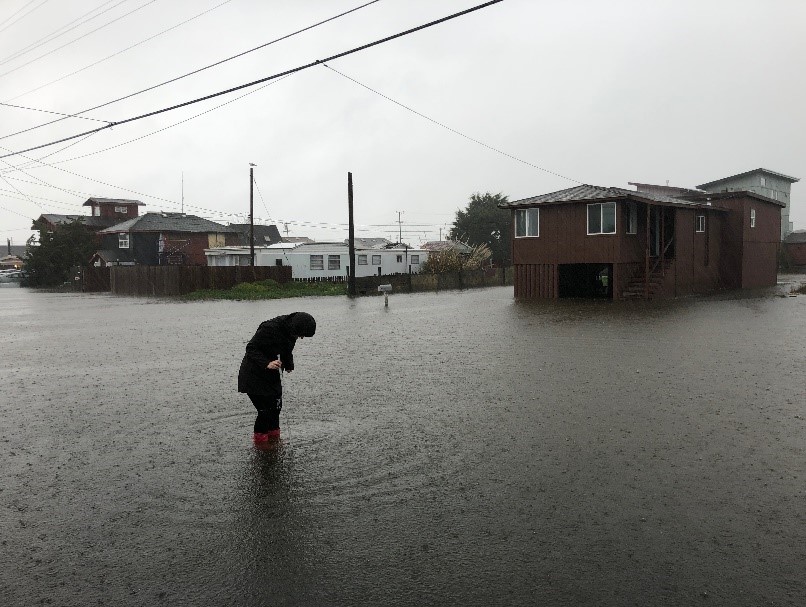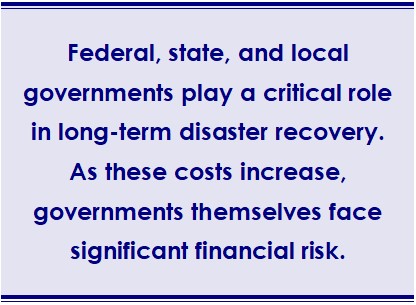You can also view this newsletter as a PDF.

Controller-sponsored Bill Would Aid in
Equitable Relocation of Vulnerable Coastal Residents
Many think of sea-level rise as being far in the future, but extreme and nuisance flooding and bluff erosion already are threatening homes in California—causing catastrophic financial and environmental impacts. For example, in 2016, officials condemned multiple houses in Pacifica when a bluff eroded, leaving portions of the homes hanging from the cliff. Further north, the community of King Salmon in the Humboldt Bay regularly experiences destructive tidal flooding, with residents describing saltwater seeping up through the floorboards, entering the engines of vehicles parked on streets, and making roads impassable.

Economics of Sea-level Rise
As California’s chief fiscal officer, Controller Yee realizes the riskiest response to sea-level rise is inaction. Within the next three decades, sea-level rise is forecasted to threaten between $8 billion and $20 billion of property on California’s coastline. Indigenous and low-income people of color would bear disproportionate impacts.
The full economic effect of sea-level rise extends far beyond the value of physical structures. As the ocean encroaches on sandy beaches, total available beach area is reduced, so fewer people can visit the beach. Although California’s beaches are free to visit, beach recreation is of value to the economy. Researchers found that people are willing to pay, on average, $42 for a day at the beach. Fewer beach visitors means less spending at local establishments for food and beverage, gas, parking, and lodging, affecting coastal businesses and associated wages and jobs. Tax revenues also are reduced when fewer people are able to visit the beach; lower spending means fewer dollars are collected in city and county sales taxes and local transient occupancy taxes.
When we compare all of these economic losses to the cost of adaptation projects, the net benefits almost always are positive. Beaches also provide ecological value as important habitat for threatened species, storm-buffering services, and protection from upland erosion, all of which have financial value that can be assessed.
Adaptation Strategies
Controller Yee believes it is important that adaptation strategies be designed to meet the individual needs of each of California’s diverse communities. A February report by the United Nations’ Intergovernmental Panel on Climate Change reiterated, “justice and equity have a significant impact on how effective adaptation can be.”
Controller Yee wants to see historically excluded communities prioritized at every step in the process and these communities’ needs centered in all adaptation decisions.
Sea-level rise adaptation generally is divided into three distinct categories: protect, accommodate, or relocate.
Building seawalls to protect properties from rising waters is generally considered the most extreme and expensive form of sea-level rise adaptation. However, it may be necessary for major infrastructure like ports along the coast. A less extreme version of protection involves strengthening or elevating existing structures. Protection satisfies short-term threats, but it is likely to be ineffective and environmentally detrimental in the long run.
Accommodation is easier to execute and less invasive. This can include living shorelines that provide erosion control using organic materials, or building infrastructure that embraces rising waters such as parking garages to act as reservoirs during flood events.
When possible and practical, the most effective way to avoid the impacts of sea-level rise is to relocate, moving people and property away from rising seas.
Policy Solutions
Controller Yee is sponsoring SB 1078 (Allen), an innovative adaptation solution aligned with statewide sea-level rise policy and the best available science. Specifically, the voluntary pilot program would provide local jurisdictions with low-interest loans to purchase vulnerable coastal properties in historically neglected communities and rent them back to current residents until the homes are no longer habitable.
Under the program, interested local jurisdictions would submit applications with an in-depth evaluation of the public benefits of property acquisition. Local jurisdictions would also be required to develop a detailed plan for future removal of structures when they become uninhabitable and identify funding sources for removal.
In the United States, most buyout policies are knee-jerk responses to natural disasters and require residents to immediately abandon the property, negatively affecting renters and adding stress to regional housing needs. SB 1078 avoids this by providing the state with an invaluable opportunity to plan ahead within a pre-disaster context. It allows residents to remain in a bought-out home for the immediate future, balancing time for preparation with the critical need for housing. Controller Yee hopes future policy solutions will complement this work by supporting planning for local coastal jurisdictions and affordable housing outside of hazard zones.
Moving Forward
Without major interventions, entire communities could be lost in just a few decades, along with valuable shorelines accessible to all people in California. A short window of opportunity remains for California leaders to get ahead of the curve and invest in innovative, proactive sea-level rise policy.
Climate Resilience Critical to Maintaining California's Fiscal Health
When wildfire, drought, flood, extreme heat, or another natural disaster strikes a community, the costs in life, health, and property can be immediate and immense. These costs can stretch on for years as the region seeks to recover. A recent series of reports from the nonpartisan Legislative Analyst’s Office outlines in dire terms how these costs will permeate various sectors of California’s economy.
Costs are borne most directly at the local level, by those who endure the disaster and its impacts. However, federal, state, and local governments play a critical role in long-term recovery by rebuilding infrastructure, providing aid for uninsured property losses, and supporting economic adaptation and revitalization. As these recovery costs increase, governments themselves face significant fiscal risk.
Up-front investments in adaptation and resilience can protect lives and significantly reduce the economic and fiscal impacts of the changing climate. Controller Yee believes California’s budget must continue to prioritize coordinated climate mitigation, adaptation, and resilience investments to maintain the state’s fiscal health.

Climate Risks
Californians already are suffering the impacts of the changing climate. Average annual temperatures across the state have increased 1°F, with some areas exceeding 2°F—contributing to a heat crisis in many communities. The 2020-21 water year was the second-driest two-year period on record, resulting in $1.7 billion in economic costs across the agricultural sector and the loss of nearly 15,000 jobs. On the coast, the sea level has begun to rise, causing saltwater infiltration in aquifers. Precipitation across the Sierras has become less predictable, contributing to more severe wildfires.
The toll to the broader California economy already is concerning. California’s record-breaking wildfires, over the course of just two years, contributed to bankruptcy of the nation’s largest utility, caused billions in losses from uninsured or underinsured properties, and led to negative health impacts from wildfire smoke across much of the state. Last year, the two-week evacuation of South Lake Tahoe during the Caldor Fire cost local businesses an estimated $93 million in lost revenue, according to the Center for Economic Development at University of Nevada, Reno.
 The Cost of Recovery: A Budget Risk
The Cost of Recovery: A Budget Risk
The costs of disasters, and even the risk of disaster, pose unique fiscal challenges to governments. A first-of-its-kind analysis by the White House Office of Management and Budget found that the federal government could spend an additional $25 billion to $128 billion annually due to climate-related disaster risk including disaster relief, flood insurance, crop insurance, and other relief efforts. As an example, the analysis projected an increase in federal crop insurance premium subsidies of between $330 million and $2.1 billion a year due to climate change-induced crop losses by late this century.
Additionally, in a worst-case climate change scenario, the analysis estimates federal revenues could be $2 trillion lower annually by 2100.
These costs pose a systemic risk to governmental budgets. Researchers at the Bennett Institute for Public Policy indicate 63 out of 108 governments that issue sovereign debt, including the U.S., could experience climate-induced credit downgrades by 2030 if global emissions targets are not met.
These budget impacts extend to local governments, as well. Credit rating agencies have begun incorporating climate change and sustainability factors into their ratings of states, counties, and cities nationwide, moving local governments to begin to address climate risk.
Investment in Adaptation and Resilience
California has taken a whole-of-government approach to resilience, making significant financial commitments toward helping communities adapt to a new climate and be more resilient to major natural disasters. In last year’s budget alone, the state committed to a three-year $3.7 billion investment in climate resilience, including $800 million to address extreme heat, $612 million for sea-level rise, and $819 for a variety of community resilience programs.
An additional $5.2 million was committed for water and drought resilience, and $1.5 billion to address wildfire and forest resilience.
These funding commitments have launched or strengthened a wide variety of programs aimed specifically at helping individuals, communities, and businesses.
Ultimately, these up-front investments on resilience can reduce the impacts of climate change and help protect the state’s financial resources. The fiscal benefits of investing in climate resilience are difficult to quantify. However, one survey study shows a cost-benefit ratio ranging from 3:1 to 50:1.
Coordination and Transparency
In taking a whole-of-government approach to climate change adaptation and resilience, California is forging a progressive path for its economy. The California Natural Resources Agency has launched an updated climate adaptation strategy to help guide these investments.
For these investments to be effective, Controller Yee believes leaders must ensure they meet the needs of California’s most vulnerable residents and communities. In addition, funding needs to be coordinated and transparent, allowing the state to evaluate and improve its funding approaches over time.
With that in mind, Controller Yee is sponsoring Senate Bill 1123 (Caballero) to improve access, transparency, and effectiveness of state adaptation and resilience funding. This legislation aims to provide improved access to a wide variety of resources for individuals and communities through a resilience navigators program hosted by the Integrated Climate Adaptation and Resilience Program.
Navigators could help a community identify and connect with support to undertake distributed energy generation, home and community hardening, establishing a resilience center, and improving community ingress and egress.
SB 1123 also would require transparency and accountability for all funds being spent to support resilience. Data and improved coordination are critical to helping agencies, communities, and other stakeholders understand where funds are being spent, how programs are addressing the most critical needs, and how they can be improved over time.
Investments in resilience are critical to protecting the most vulnerable Californians and preserving the state’s economic and fiscal health. Controller Yee believes—with increased access, transparency, and accountability—California leaders can ensure limited resources are being used efficiently and effectively to protect communities in a climate-changed world.